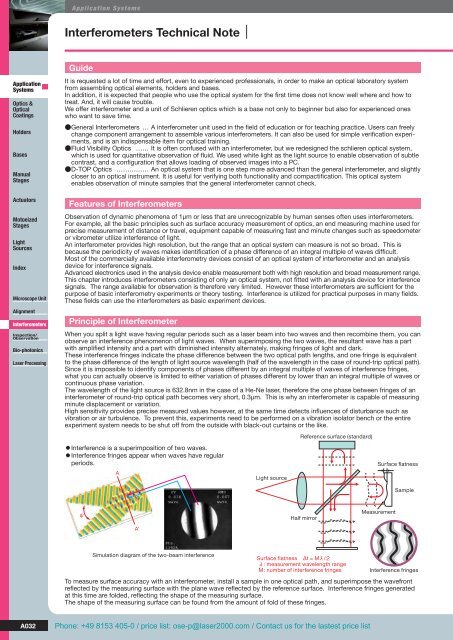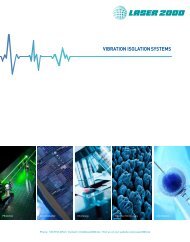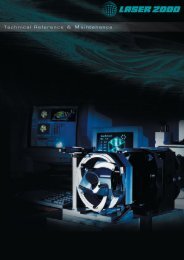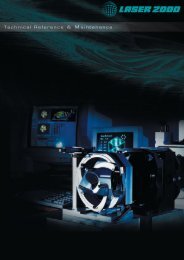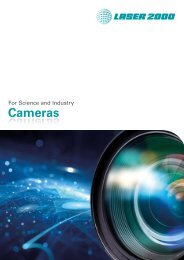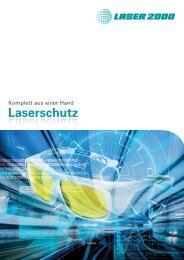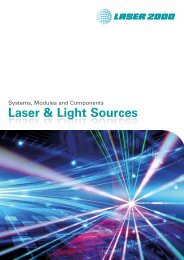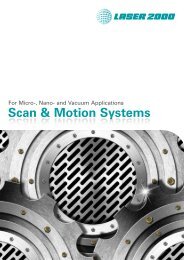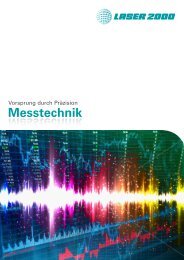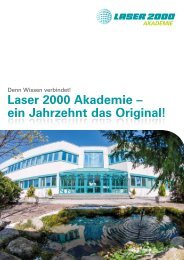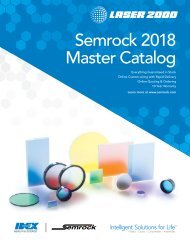- Page 1 and 2: Phone: +49 8153 405-0 / price list:
- Page 3 and 4: Phone: +49 8153 405-0 / price list:
- Page 5 and 6: Phone: +49 8153 405-0 / price list:
- Page 7 and 8: Phone: +49 8153 405-0 / price list:
- Page 9 and 10: Application Systems Phone: +49 8153
- Page 11 and 12: Application Systems I N D E X
- Page 13 and 14: System Diagram Zoom Microscope Colo
- Page 15 and 16: Automated 12-axis Optical Fiber Ali
- Page 17 and 18: APAS (Automatic Polarization Analys
- Page 19 and 20: Laser Processing Systems Guide Due
- Page 21 and 22: Application Systems Optics & Optica
- Page 23 and 24: System Diagram Controller Cable SZL
- Page 25 and 26: Partial light blocking cassette—Z
- Page 27 and 28: Observation unit with coaxial illum
- Page 29 and 30: Auto Focus (Separate type) TAF-ES-D
- Page 31 and 32: Catalog Intelligent Positioning Sys
- Page 33 and 34: LED Ring Illuminators—SKLIR-1 The
- Page 35 and 36: Machine Vision and Image Transfer O
- Page 37 and 38: Motorized 3-axis XYθ Stage Unit DA
- Page 39: Softwares ASS Alignment Software
- Page 43 and 44: Experiment Method After assembling
- Page 45 and 46: Camera Observation Unit—IFS2-CMR
- Page 47 and 48: Beamsplitter Component—IFC2-BS Ca
- Page 49 and 50: Steel Honeycomb Optical Tabie—OSD
- Page 51 and 52: D-TOP Base plate—DBSP-1 It is a b
- Page 53 and 54: Coherent Length Measuring Machine
- Page 55 and 56: PBS Module—DTM-PBS-20-6328 Catalo
- Page 57 and 58: Catalog Code W2044 Optical Characte
- Page 59 and 60: Polarization component We will prov
- Page 61 and 62: Catalog Code W2019 Application Syst
- Page 63 and 64: Laser Optical tweezers - Mini type
- Page 65 and 66: Shutter Systems for Microscope BSH2
- Page 67 and 68: BIOS-Light for upright microscope B
- Page 69 and 70: Motorized XY stage system for uprig
- Page 71 and 72: Processing software It is a softwar
- Page 73 and 74: Surface accuracy guarantee mirror G
- Page 75 and 76: Specifications Control method Outpu
- Page 77 and 78: LD + Power supply for Photodiode dr
- Page 79 and 80: Optics & Optical Coatings Phone: +4
- Page 81 and 82: Optics & Optical Coatings I N D E X
- Page 83 and 84: Laser Safety Laser light irradiatin
- Page 85 and 86: Phone: +49 8153 405-0 / price list:
- Page 87 and 88: Mirrors Selection Guide Mirrors des
- Page 89 and 90: Catalog Low Dispersion Mirrors for
- Page 91 and 92:
Negative Dispersion Mirrors for Fem
- Page 93 and 94:
Outline Drawing (in mm) GMMUHP-24.4
- Page 95 and 96:
Catalog Code W3002 355 − 1064nm P
- Page 97 and 98:
Catalog Code W3003 355 − 1064nm P
- Page 99 and 100:
Catalog Code W3006 Typical Reflecta
- Page 101 and 102:
Catalog Code W3007 Typical Reflecta
- Page 103 and 104:
Catalog Code W3008 Typical Reflecta
- Page 105 and 106:
0-45° Wide Incidence Dielectric Mi
- Page 107 and 108:
Typical Reflectance Data R: Reflect
- Page 109 and 110:
Catalog Code W3010 Circle Al+MgF2 (
- Page 111 and 112:
Rectangle Al+MgF2 (partially Al+SiO
- Page 113 and 114:
Reasonable Aluminum Flat Mirrors S-
- Page 115 and 116:
Paraboloid mirror TCPA Catalog Code
- Page 117 and 118:
Catalog Code W3011 ■Gold Flat Mir
- Page 119 and 120:
Contact sheet Contact sheet for Spe
- Page 121 and 122:
Beamsplitters Phone: +49 8153 405-0
- Page 123 and 124:
Beamsplitters selection Guide A bea
- Page 125 and 126:
Catalog Code W3012 Cube Type: Nonpo
- Page 127 and 128:
Catalog Chromium Cube Half Mirrors
- Page 129 and 130:
Catalog Code W3015 Typical Transmit
- Page 131 and 132:
Catalog Code W3016 Typical Transmit
- Page 133 and 134:
Catalog Laser Line Plate Half Mirro
- Page 135 and 136:
Typical Reflectance Data & Typical
- Page 137 and 138:
Application Note About light behavi
- Page 139 and 140:
Catalog Dielectric Plate Beamsplitt
- Page 141 and 142:
Catalog Code Catalog Code W3022 W30
- Page 143 and 144:
Catalog Code W3024 Typical Reflecta
- Page 145 and 146:
Catalog Polka dot beam splitter PDB
- Page 147 and 148:
Catalog Code W3174 Typical Reflecta
- Page 149 and 150:
Polarizers Phone: +49 8153 405-0 /
- Page 151 and 152:
Polarizers Selection Guide Human ey
- Page 153 and 154:
Catalog Code W3026 Typical Transmit
- Page 155 and 156:
Catalog Broadband Polarizing Beamsp
- Page 157 and 158:
Catalog Polarizing Beamsplitters PB
- Page 159 and 160:
Contact sheet Contact sheet for pol
- Page 161 and 162:
Quarter waveplate (λ/4 retardation
- Page 163 and 164:
Catalog Code W3030 Typical Angular
- Page 165 and 166:
Quartz Waveplates WPQ Quartz wavepl
- Page 167 and 168:
Catalog Quartz Depolarizers DEQ Cod
- Page 169 and 170:
Catalog Fresnel Rhomb Waveplates FR
- Page 171 and 172:
3Perpendicular to the sample axis E
- Page 173 and 174:
Catalog Glan Laser Prisms GLPB/GLPC
- Page 175 and 176:
Catalog Wollaston Prisms WPPB/WPPC
- Page 177 and 178:
Catalog Sheet Polarizers SPF/NSPFU/
- Page 179 and 180:
Catalog Polarcor Polarizers PLC Cod
- Page 181 and 182:
Catalog Z-polarizer Custom-made Cod
- Page 183 and 184:
Phone: +49 8153 405-0 / price list:
- Page 185 and 186:
Lenses Selection Guide These Lenses
- Page 187 and 188:
Catalog Code W3041 BK7 φ5 − φ12
- Page 189 and 190:
Catalog Code W3043 BK7 φ30 − φ4
- Page 191 and 192:
Catalog Code W3044 BK7 φ80 − φ1
- Page 193 and 194:
Catalog Code W3046 Synthetic fused
- Page 195 and 196:
Catalog Code W3048 Synthetic fused
- Page 197 and 198:
Catalog Code W3050 BK7 φ10 − φ2
- Page 199 and 200:
Catalog Code W3052 Synthetic fused
- Page 201 and 202:
Biconvex Lenses SLB-B-P/SLSQ-B-P Wi
- Page 203 and 204:
Catalog Code W3056 BK7 φ25 − φ5
- Page 205 and 206:
Catalog Code W3058 Synthetic fused
- Page 207 and 208:
Biconcave Lenses SLB-B-N/SLSQ-B-N W
- Page 209 and 210:
Catalog Code W3061 Synthetic fused
- Page 211 and 212:
Contact sheet Contact sheet for Spe
- Page 213 and 214:
Catalog Code W3185 Plano Convex Len
- Page 215 and 216:
Catalog Code W3185 Biconvex Lens Pa
- Page 217 and 218:
Catalog Code W3186 Plano Concave Le
- Page 219 and 220:
Catalog Code W3062 BK7 10×10mm −
- Page 221 and 222:
Catalog Code W3064 BK7 30×40mm −
- Page 223 and 224:
Catalog Code W3066 Synthetic fused
- Page 225 and 226:
Cylindrical Plano-concave Lenses CL
- Page 227 and 228:
Catalog Code W3069 Synthetic fused
- Page 229 and 230:
Rod Lenses RODB Catalog Code W3070
- Page 231 and 232:
Fresnel Lens FRL Catalog Code W3184
- Page 233 and 234:
Catalog Code W3071 Uncoated Part Nu
- Page 235 and 236:
Catalog Code W3072 Plano Convex Par
- Page 237 and 238:
Aspheric Condenser Lenses AGL Catal
- Page 239 and 240:
FAC Collimated Lens Custom-made Cat
- Page 241 and 242:
Sapphire Plano Convex Lens SLSH Cat
- Page 243 and 244:
Meniscus Lens for CO2 Laser SLZS2 C
- Page 245 and 246:
Germanium Single Lens SLGE Catalog
- Page 247 and 248:
Multi-Element Optics Phone: +49 815
- Page 249 and 250:
ME-Optics Selection Guide The lens
- Page 251 and 252:
Catalog Code W3075 φ10 − φ25 Pa
- Page 253 and 254:
Catalog Code W3077 φ50 − φ100 P
- Page 255 and 256:
Catalog Negative achromatic lens DL
- Page 257 and 258:
Catalog Achromatic cylindrical lens
- Page 259 and 260:
YAG Laser Focusing Lenses NYTL/NYDL
- Page 261 and 262:
Protective Windows / Protective Win
- Page 263 and 264:
Ultra-violet Achromats UDL/NUDL Cat
- Page 265 and 266:
Catalog Code W3084 Schematic Galvan
- Page 267 and 268:
3-Wavelengths Objective Lens NPAL-Y
- Page 269 and 270:
Catalog Code W3089 266nm Part Numbe
- Page 271 and 272:
Infrared (NIR) Objective Lenses LMP
- Page 273 and 274:
Catalog Long Working Distance Objec
- Page 275 and 276:
Reflective Microscope Objectives Le
- Page 277 and 278:
Catalog High-power zoom type laser
- Page 279 and 280:
Catalog Code W3091 Specifications P
- Page 281 and 282:
Contact sheet Contact sheet for Las
- Page 283 and 284:
Catalog Focus Tunable lens EL-10-30
- Page 285 and 286:
Catalog Laser Beam Expanders for CO
- Page 287 and 288:
Phone: +49 8153 405-0 / price list:
- Page 289 and 290:
Filters Selection Guide There is a
- Page 291 and 292:
Absorptive Neutral Density Filter (
- Page 293 and 294:
Typical Transmittance Data T: Trans
- Page 295 and 296:
Catalog Code W3095 Square (□10
- Page 297 and 298:
Reflective Neutral Density Filter (
- Page 299 and 300:
Typical Transmittance Data T: Trans
- Page 301 and 302:
Typical Transmittance Data T: Trans
- Page 303 and 304:
Circle Rectangle Part Number Wavele
- Page 305 and 306:
Beam Shaping Diffuser MDFPC Catalog
- Page 307 and 308:
Opal Diffusion Glass DFO Catalog Co
- Page 309 and 310:
IR Transmitting Filters ITF Catalog
- Page 311 and 312:
Blue and Green Filters BLF/GRF Cata
- Page 313 and 314:
Heat Absorbing Filters HAF Catalog
- Page 315 and 316:
Color Correction Filter CCF/ECM Cat
- Page 317 and 318:
Visible range dichroic filters DIF
- Page 319 and 320:
Visible range dichroic filters DIM
- Page 321 and 322:
Cold Mirrors CLDM Catalog Code W311
- Page 323 and 324:
Catalog Short Pass Filters SHPF Cod
- Page 325 and 326:
Catalog Raman Long Pass Edge Filter
- Page 327 and 328:
Catalog Code W3117 Typical Transmit
- Page 329 and 330:
Interference filters YIF YIF is a f
- Page 331 and 332:
Interference filters YIF Typical Tr
- Page 333 and 334:
Catalog Code W3119 214.0nm − 647.
- Page 335 and 336:
Bandpass Interference filters VPF C
- Page 337 and 338:
Typical Transmittance & Optical Den
- Page 339 and 340:
Contact Sheet Catalog Code W3218 Fi
- Page 341 and 342:
Phone: +49 8153 405-0 / price list:
- Page 343 and 344:
Prisms Selection Guide By processin
- Page 345 and 346:
Catalog Code W3123 Schematic 45° w
- Page 347 and 348:
BK7 / Simple Part Number A = B [mm]
- Page 349 and 350:
Knife Edge Right Angle Prisms (with
- Page 351 and 352:
Hollow Retro-reflectors RCCB Catalo
- Page 353 and 354:
Catalog Code W3129 BK7 Part Number
- Page 355 and 356:
Penta Prisms Brewster dispersing li
- Page 357 and 358:
Light Pipe LPB/LPSQ Catalog Code W3
- Page 359 and 360:
Prism Sheet PRS Catalog Code W3214
- Page 361 and 362:
Substrates & Windows Phone: +49 815
- Page 363 and 364:
Substrates & Windows Selection Guid
- Page 365 and 366:
Optical Flats OFB/OFBP/OFSQ/OFPXP/O
- Page 367 and 368:
Catalog Code W3134 Rectangle Part N
- Page 369 and 370:
Float glass OPFL Catalog Code W3216
- Page 371 and 372:
Catalog Code W3135 BK7/Circle φ10
- Page 373 and 374:
Catalog Code W3136 BK7/Square □10
- Page 375 and 376:
Catalog Code W3137 Synthetic fused
- Page 377 and 378:
Optical flats with hole Custom-made
- Page 379 and 380:
Catalog Wedged Substrates WSB/WSSQ/
- Page 381 and 382:
Contact sheet Contact sheet for Cus
- Page 383 and 384:
Catalog Code W3142 φ15 − φ20 Su
- Page 385 and 386:
Catalog Code W3142 φ40 − φ50 Su
- Page 387 and 388:
Catalog Code W3143 φ20 − φ25 Pa
- Page 389 and 390:
Contact sheet Contact sheet for Spe
- Page 391 and 392:
Standard type Part Number Diameter
- Page 393 and 394:
Contact sheet Contact sheet for Spe
- Page 395 and 396:
AR Coated Windows for High Power La
- Page 397 and 398:
Sapphire Windows for Infrared Laser
- Page 399 and 400:
ZnSe Windows for Infrared Laser OPZ
- Page 401 and 402:
Silicon Windows for Infrared Laser
- Page 403 and 404:
Brewster Windows Custom-made Catalo
- Page 405 and 406:
Technical Referenceaintenance Phone
- Page 407 and 408:
Glass Materials Glass materials use
- Page 409 and 410:
Low Expansion Glass Materials If a
- Page 411 and 412:
Calcium Fluoride The natural minera
- Page 413 and 414:
Dielectric Coating Dielectric mater
- Page 415 and 416:
Properties of Multi-layer Coating W
- Page 417 and 418:
Catalog Thin film design software (
- Page 419 and 420:
Traceability All products produced
- Page 421 and 422:
Lens formula Focal length of Lens c
- Page 423 and 424:
Optical Tool Kits / Optical Cleanin
- Page 425 and 426:
Wiping Cloth SWC SWC W3161 Cloth fo
- Page 427 and 428:
Phone: +49 8153 405-0 / price list:
- Page 429 and 430:
H o l d e r s I N D E X
- Page 431 and 432:
Alignment Light cannot be touched,
- Page 433 and 434:
How to convert Stand or Post of Hol
- Page 435 and 436:
(3) Fine Adjustment Center Mirror h
- Page 437 and 438:
Mirror holder that can be used by t
- Page 439 and 440:
Kinematic Mirror Mount MHGT Catalog
- Page 441 and 442:
Catalog Code W4001 Outline Drawing
- Page 443 and 444:
Options for Kinematic Mirror Holder
- Page 445 and 446:
Catalog Vertical Control Small Mirr
- Page 447 and 448:
Catalog Code W4009 Specifications P
- Page 449 and 450:
Catalog Code W4012 Outline Drawing
- Page 451 and 452:
Plates for Topmike Vertical Control
- Page 453 and 454:
Catalog Code W4010 Outline Drawing
- Page 455 and 456:
Micrometer Indicator Conversion MHE
- Page 457 and 458:
Plates for Larger Precision Gimbal
- Page 459 and 460:
Introducing Other Mirror Holders Yo
- Page 461 and 462:
Catalog Fixed Lens Holders LHF/LHF-
- Page 463 and 464:
I I Catalog Three-axis/Five-axis Le
- Page 465 and 466:
Retaining Rings/Delrin Washers Reta
- Page 467 and 468:
Caliper Variable Lens Holders SLH *
- Page 469 and 470:
Selfoc ® Lens Claws MLH Catalog Co
- Page 471 and 472:
60 Fixed Multi-element Lens Holders
- Page 473 and 474:
Catalog Prism Holders KKD/PLH/PAD C
- Page 475 and 476:
Polarizer Holders MPH/PH/SPH Holder
- Page 477 and 478:
Polarizing Prism Holders GTPC-PH/GT
- Page 479 and 480:
Laser Holders (Kinematic) LAH-3 Cat
- Page 481 and 482:
Laser Beam Expanders with holder LB
- Page 483 and 484:
Technical Note Spacial Filters The
- Page 485 and 486:
Precision Pinhole/Air Slits PA/FSL
- Page 487 and 488:
Iris Diaphragm Holders IH Catalog C
- Page 489 and 490:
Adjustable Slits PSL/SLX Catalog Co
- Page 491 and 492:
Filter Holders FHS/FH Catalog Code
- Page 493 and 494:
Catalog Shutter Controller SSH-C W4
- Page 495 and 496:
Light Shade plate BBP Catalog Code
- Page 497 and 498:
Fiber Optics Mounts FOM Catalog Cod
- Page 499 and 500:
Fiber Optics Holders OFH/OFH-DM Cat
- Page 501 and 502:
SMA Type Fiber Optics Holders FOP-S
- Page 503 and 504:
Phone: +49 8153 405-0 / price list:
- Page 505 and 506:
B a s e s I N D E X
- Page 507 and 508:
Structure of Flat Benches ◦Optica
- Page 509 and 510:
High-performance Vibration Isolatio
- Page 511 and 512:
Steel Honeycomb Optical Tables OSDV
- Page 513 and 514:
Desktop Vibration Isolation Systems
- Page 515 and 516:
Overhead Table Shelf System OSDOTS
- Page 517 and 518:
Guide on Special Orders for Vibrati
- Page 519 and 520:
Rubber Isolators PR Catalog Code W6
- Page 521 and 522:
Clean Darkroom Equipment Spirit Lev
- Page 523 and 524:
Conversion Adapters Conversion Size
- Page 525 and 526:
Carriers for Large Optical Rails CA
- Page 527 and 528:
Carriers for Medium Optical Rails F
- Page 529 and 530:
Specifications Part Number M4 M6 IN
- Page 531 and 532:
Application Systems Optics & Optica
- Page 533 and 534:
Kinematic Bases/Kinematic Base Plat
- Page 535 and 536:
Optical Baseplates OBB/OBC Catalog
- Page 537 and 538:
Outline Drawing OBC-1216 Hexagonal
- Page 539 and 540:
Catalog Aluminum Spacers (□60mm)
- Page 541 and 542:
Post Stand Guide It is available fo
- Page 543 and 544:
Adapter Plates for Pedestal / Pedes
- Page 545 and 546:
Post Holders RS Catalog Code W6044
- Page 547 and 548:
Clamp Screws (For post holders) Hel
- Page 549 and 550:
Poles PO Catalog Code W6053 Stainle
- Page 551 and 552:
Posts Thread Adapters RO-EE/UU CHS
- Page 553 and 554:
Rotary Cross Clamps CRHN Catalog Co
- Page 555 and 556:
Catalog Code W6056 Outline Drawing
- Page 557 and 558:
Adapter Plate Selection Guide A var
- Page 559 and 560:
Top Plates for TAR—SP-109 ◦Moun
- Page 561 and 562:
Top Plate Adapters for TAS-2060—S
- Page 563 and 564:
Conversion Plate—SP-201 ◦It is
- Page 565 and 566:
Screw Set Adapter Nuts SCR / SKB /
- Page 567 and 568:
Manual Positioners Phone: +49 8153
- Page 569 and 570:
Manual Positioners I N D E X
- Page 571 and 572:
How to Read Micrometer Head and Ver
- Page 573 and 574:
Ball Guide Method (TSD/TSDH/TSDT/TS
- Page 575 and 576:
θ axis Stages Guide Stages used fo
- Page 577 and 578:
Ball Guide Method (GOHT/GOHTA Serie
- Page 579 and 580:
■Straightness (vertical direction
- Page 581 and 582:
Goniometer Stage [Test Procedure] R
- Page 583 and 584:
Catalog Code W7003 Outline Drawing
- Page 585 and 586:
Catalog Code Catalog Code W7001 W70
- Page 587 and 588:
Catalog Code Catalog Code W7002 W70
- Page 589 and 590:
Catalog Code Catalog Code W7004 W70
- Page 591 and 592:
Catalog Code W7113 Outline Drawing
- Page 593 and 594:
Catalog Code W7114 Outline Drawing
- Page 595 and 596:
Catalog Code Catalog Code W7006 W70
- Page 597 and 598:
Catalog Code Catalog Code W7007 W70
- Page 599 and 600:
Catalog Code W7008 Outline Drawing
- Page 601 and 602:
Catalog Code W7029 Outline Drawing
- Page 603 and 604:
Catalog Code Catalog Code W7009 W70
- Page 605 and 606:
Catalog Code Catalog Code W7115 W71
- Page 607 and 608:
Catalog Code Catalog Code W7117 W71
- Page 609 and 610:
Catalog Code Catalog Code W7119 W71
- Page 611 and 612:
Catalog Code Catalog Code W7121 W71
- Page 613 and 614:
I I I I I I Catalog Code Catalog Co
- Page 615 and 616:
Catalog Code Catalog Code W7012 W70
- Page 617 and 618:
Catalog Code W7123 Outline Drawing
- Page 619 and 620:
Catalog Code W7124 Outline Drawing
- Page 621 and 622:
Catalog Code Catalog Code W7014 W70
- Page 623 and 624:
Catalog Code Catalog Code W7015 W70
- Page 625 and 626:
Catalog Code W7125 Outline Drawing
- Page 627 and 628:
Catalog Code W7126 Outline Drawing
- Page 629 and 630:
Catalog Code Catalog Code W7016 W70
- Page 631 and 632:
Catalog Code W7018 Outline Drawing
- Page 633 and 634:
Catalog Code W7038 Outline Drawing
- Page 635 and 636:
Catalog Code Catalog Code W7127 W71
- Page 637 and 638:
Catalog Code Catalog Code W7129 W71
- Page 639 and 640:
Catalog Code W7019 Outline Drawing
- Page 641 and 642:
Catalog Code W7201 Outline Drawing
- Page 643 and 644:
Catalog Code W7020 Catalog Code W70
- Page 645 and 646:
Catalog Code W7021 Outline Drawing
- Page 647 and 648:
Catalog Code Catalog Code W7022 W75
- Page 649 and 650:
Catalog Code W7040 Outline Drawing
- Page 651 and 652:
Catalog Code W7023 Outline Drawing
- Page 653 and 654:
Catalog Code Catalog Code W7041 W75
- Page 655 and 656:
Catalog Code W7042 Outline Drawing
- Page 657 and 658:
Catalog Code W7044 Outline Drawing
- Page 659 and 660:
Catalog Z axis General-purpose type
- Page 661 and 662:
Catalog Code W7049 Outline Drawing
- Page 663 and 664:
Catalog Code W7132 Outline Drawing
- Page 665 and 666:
Catalog Code W7050 Outline Drawing
- Page 667 and 668:
Catalog Code W7135 Outline Drawing
- Page 669 and 670:
Catalog Code W7051 Outline Drawing
- Page 671 and 672:
Catalog Z axis Dual Drive Rack and
- Page 673 and 674:
70 50 70 50 70 50 Catalog Code W705
- Page 675 and 676:
Catalog Code W7055 Outline Drawing
- Page 677 and 678:
Catalog Code W7136 Outline Drawing
- Page 679 and 680:
Catalog Code W7057 Outline Drawing
- Page 681 and 682:
High Load Capacity Jacks TSM Stage
- Page 683 and 684:
Catalog Code Catalog Code W7058 W70
- Page 685 and 686:
Catalog Code Catalog Code W7060 W71
- Page 687 and 688:
Catalog Code Catalog Code W7061 W70
- Page 689 and 690:
Catalog Code W7063 Outline Drawing
- Page 691 and 692:
Catalog Code Catalog Code W7065 W70
- Page 693 and 694:
Catalog Code Catalog Code W7067 W71
- Page 695 and 696:
Catalog Code W7202 Outline Drawing
- Page 697 and 698:
Catalog Code W7202 Outline Drawing
- Page 699 and 700:
Catalog Code W7203 Outline Drawing
- Page 701 and 702:
Catalog XZ axis Fine and Coarse Dri
- Page 703 and 704:
Catalog Code Catalog Code W7071 W70
- Page 705 and 706:
Catalog Code Catalog Code W7073 W71
- Page 707 and 708:
Catalog Code Catalog Code W7074 W70
- Page 709 and 710:
Catalog Code W7142 Outline Drawing
- Page 711 and 712:
Catalog Code Catalog Code W7077 W70
- Page 713 and 714:
Catalog Code Catalog Code W7079 W71
- Page 715 and 716:
Catalog Code W7081 Outline Drawing
- Page 717 and 718:
Catalog Code W7081 Outline Drawing
- Page 719 and 720:
Catalog Code W7082 Outline Drawing
- Page 721 and 722:
Catalog Code W7083 Catalog Code W70
- Page 723 and 724:
Catalog Code W7085 Outline Drawing
- Page 725 and 726:
Catalog Code Catalog Code W7086 W70
- Page 727 and 728:
Catalog Code W7090 Outline Drawing
- Page 729 and 730:
Catalog Code W7091 Outline Drawing
- Page 731 and 732:
Catalog θ axis Rotation Stages (Wo
- Page 733 and 734:
Catalog Code W7507 Outline Drawing
- Page 735 and 736:
Catalog Code W7092 Outline Drawing
- Page 737 and 738:
Catalog Code W7104 Outline Drawing
- Page 739 and 740:
Catalog Code Catalog Code W7093 W71
- Page 741 and 742:
Catalog Code Catalog Code W7144 W71
- Page 743 and 744:
Catalog Code W7146 Outline Drawing
- Page 745 and 746:
Catalog Code W7147 Outline Drawing
- Page 747 and 748:
Catalog Code W7148 Outline Drawing
- Page 749 and 750:
Catalog Code W7097 Catalog Code Cat
- Page 751 and 752:
I I Catalog Code Catalog Code W7098
- Page 753 and 754:
Catalog Code W7100 Catalog Code W71
- Page 755 and 756:
Catalog Code Catalog Code W7150 W71
- Page 757 and 758:
α axis Screw Goniometers with V-Gr
- Page 759 and 760:
θαβ axis Stages KKD Catalog Code
- Page 761 and 762:
Catalog Code W7110 Guide ▶Since t
- Page 763 and 764:
Catalog Code W7512 Outline Drawing
- Page 765 and 766:
Vacuum Guidance for Stainless Steel
- Page 767 and 768:
Catalog Code W7005 Outline Drawing
- Page 769 and 770:
Catalog Code W7031 Outline Drawing
- Page 771 and 772:
Catalog Z axis Stainless Steel Exte
- Page 773 and 774:
Catalog Code W7064 Outline Drawing
- Page 775 and 776:
Catalog Code W7068 Outline Drawing
- Page 777 and 778:
Catalog Code W7076 Outline Drawing
- Page 779 and 780:
Catalog Code W7080 Outline Drawing
- Page 781 and 782:
α axis Stainless Steel Goniometers
- Page 783 and 784:
Phone: +49 8153 405-0 / price list:
- Page 785 and 786:
Actuator Mounting System Chart Trav
- Page 787 and 788:
Catalog Micrometer Heads (Maintenan
- Page 789 and 790:
Catalog Sub-micron Worm Drive Micro
- Page 791 and 792:
Catalog Differential Micrometer Hea
- Page 793 and 794:
Catalog Code W8008 Length 25mm Leng
- Page 795 and 796:
System Chart Remote Controller Remo
- Page 797 and 798:
Remote Control Mirror Holder Catalo
- Page 799 and 800:
R Outline Drawing SOM-C13E M9.5 P0.
- Page 801 and 802:
Catalog Code W8015 Compatible Contr
- Page 803 and 804:
Motion Control Products Phone: +49
- Page 805 and 806:
Motion Control Products I N D E X
- Page 807 and 808:
Moment Stiffness (Pitch/Yaw/Roll) M
- Page 809 and 810:
Angular Accuracy Moment Stiffness P
- Page 811 and 812:
Interpretation of the Specification
- Page 813 and 814:
Mounting Orientation The values in
- Page 815 and 816:
TAMM Series Motorized crossed rolle
- Page 817 and 818:
GS/CS series Guide Full closed loop
- Page 819 and 820:
Stabilizing (Fall-Prevention) Mecha
- Page 821 and 822:
Various cables G108 − G109 GIP-10
- Page 823 and 824:
Catalog Code W9051 Application Syst
- Page 825 and 826:
Catalog Code W9058 Free Software|SG
- Page 827 and 828:
Catalog Software for Positioning &
- Page 829 and 830:
Catalog Code W9062 Xyθ axis Set|HP
- Page 831 and 832:
Catalog Code W9061 Outline Drawing
- Page 833 and 834:
Outline Drawing HPS60-20X-M2 Hexago
- Page 835 and 836:
Catalog Code W9063 Outline Drawing
- Page 837 and 838:
Catalog Code W9064 Outline Drawing
- Page 839 and 840:
Catalog Code W9065 Outline Drawing
- Page 841 and 842:
Catalog Code W9066 Outline Drawing
- Page 843 and 844:
Catalog Code W9067 Outline Drawing
- Page 845 and 846:
Catalog Code W9068 Outline Drawing
- Page 847 and 848:
Catalog Code W9069 Outline Drawing
- Page 849 and 850:
Catalog Code W9070 Outline Drawing
- Page 851 and 852:
Catalog Code W9071 Outline Drawing
- Page 853 and 854:
Catalog Code W9072 Outline Drawing
- Page 855 and 856:
Catalog Code W9073 Outline Drawing
- Page 857 and 858:
Catalog Code W9074 Outline Drawing
- Page 859 and 860:
Catalog Code W9075 Outline Drawing
- Page 861 and 862:
Catalog Code W9076 Outline Drawing
- Page 863 and 864:
Catalog Code W9009 Outline Drawing
- Page 865 and 866:
Catalog Code W9023 Outline Drawing
- Page 867 and 868:
Catalog Code W9040 Outline Drawing
- Page 869 and 870:
Catalog Code W9024 Outline Drawing
- Page 871 and 872:
Catalog Code W9025 Outline Drawing
- Page 873 and 874:
Catalog Code W9077 Outline Drawing
- Page 875 and 876:
Catalog Code W9078 Outline Drawing
- Page 877 and 878:
Catalog Code W9027 Outline Drawing
- Page 879 and 880:
Catalog Code W9028 Outline Drawing
- Page 881 and 882:
Catalog Code W9029 Outline Drawing
- Page 883 and 884:
Catalog Code W9079 Outline Drawing
- Page 885 and 886:
Catalog Code W9079 Outline Drawing
- Page 887 and 888:
Catalog Code W9080 Outline Drawing
- Page 889 and 890:
Catalog Code W9034 Outline Drawing
- Page 891 and 892:
Catalog Code W9035 Outline Drawing
- Page 893 and 894:
●Emitted amount of gas Emitted Am
- Page 895 and 896:
Catalog Code W9081 Outline Drawing
- Page 897 and 898:
Catalog Code W9082 Outline Drawing
- Page 899 and 900:
Catalog Code W9083 Outline Drawing
- Page 901 and 902:
Catalog 2 axis Stage Controller GSC
- Page 903 and 904:
Catalog Intelligent Positioning Sys
- Page 905 and 906:
Catalog Extensible Stage Controller
- Page 907 and 908:
Catalog Code W9084 System Diagram 5
- Page 909 and 910:
Joy Stick Jog Operation Box JS-300
- Page 911 and 912:
Catalog Code W9053 Cables for preci
- Page 913 and 914:
Question Sheet Motorized Stage Syst
- Page 915 and 916:
Accuracy Measurement Example: Sigma
- Page 917 and 918:
Catalog Code Catalog Code W9054 W90
- Page 919 and 920:
Catalog SFS Controllers FINE Code W
- Page 921 and 922:
Motion Control Products Phone: +49
- Page 923 and 924:
Motion Control Products I N D E X
- Page 925 and 926:
Moment Stiffness (Pitch/Yaw/Roll) M
- Page 927 and 928:
Angular Accuracy Moment Stiffness P
- Page 929 and 930:
Interpretation of the Specification
- Page 931 and 932:
Mounting Orientation The values in
- Page 933 and 934:
TAMM Series Motorized crossed rolle
- Page 935 and 936:
GS/CS series Guide Full closed loop
- Page 937 and 938:
Stabilizing (Fall-Prevention) Mecha
- Page 939 and 940:
Various cables G108 − G109 GIP-10
- Page 941 and 942:
Catalog Code W9051 Application Syst
- Page 943 and 944:
Catalog Code W9058 Free Software|SG
- Page 945 and 946:
Catalog Software for Positioning &
- Page 947 and 948:
Catalog Code W9062 Xyθ axis Set|HP
- Page 949 and 950:
Catalog Code W9061 Outline Drawing
- Page 951 and 952:
Outline Drawing HPS60-20X-M2 Hexago
- Page 953 and 954:
Catalog Code W9063 Outline Drawing
- Page 955 and 956:
Catalog Code W9064 Outline Drawing
- Page 957 and 958:
Catalog Code W9065 Outline Drawing
- Page 959 and 960:
Catalog Code W9066 Outline Drawing
- Page 961 and 962:
Catalog Code W9067 Outline Drawing
- Page 963 and 964:
Catalog Code W9068 Outline Drawing
- Page 965 and 966:
Catalog Code W9069 Outline Drawing
- Page 967 and 968:
Catalog Code W9070 Outline Drawing
- Page 969 and 970:
Catalog Code W9071 Outline Drawing
- Page 971 and 972:
Catalog Code W9072 Outline Drawing
- Page 973 and 974:
Catalog Code W9073 Outline Drawing
- Page 975 and 976:
Catalog Code W9074 Outline Drawing
- Page 977 and 978:
Catalog Code W9075 Outline Drawing
- Page 979 and 980:
Catalog Code W9076 Outline Drawing
- Page 981 and 982:
Catalog Code W9009 Outline Drawing
- Page 983 and 984:
Catalog Code W9023 Outline Drawing
- Page 985 and 986:
Catalog Code W9040 Outline Drawing
- Page 987 and 988:
Catalog Code W9024 Outline Drawing
- Page 989 and 990:
Catalog Code W9025 Outline Drawing
- Page 991 and 992:
Catalog Code W9077 Outline Drawing
- Page 993 and 994:
Catalog Code W9078 Outline Drawing
- Page 995 and 996:
Catalog Code W9027 Outline Drawing
- Page 997 and 998:
Catalog Code W9028 Outline Drawing
- Page 999 and 1000:
Catalog Code W9029 Outline Drawing
- Page 1001 and 1002:
Catalog Code W9079 Outline Drawing
- Page 1003 and 1004:
Catalog Code W9079 Outline Drawing
- Page 1005 and 1006:
Catalog Code W9080 Outline Drawing
- Page 1007 and 1008:
Catalog Code W9034 Outline Drawing
- Page 1009 and 1010:
Catalog Code W9035 Outline Drawing
- Page 1011 and 1012:
●Emitted amount of gas Emitted Am
- Page 1013 and 1014:
Catalog Code W9081 Outline Drawing
- Page 1015 and 1016:
Catalog Code W9082 Outline Drawing
- Page 1017 and 1018:
Catalog Code W9083 Outline Drawing
- Page 1019 and 1020:
Catalog 2 axis Stage Controller GSC
- Page 1021 and 1022:
Catalog Intelligent Positioning Sys
- Page 1023 and 1024:
Catalog Extensible Stage Controller
- Page 1025 and 1026:
Catalog Code W9084 System Diagram 5
- Page 1027 and 1028:
Joy Stick Jog Operation Box JS-300
- Page 1029 and 1030:
Catalog Code W9053 Cables for preci
- Page 1031 and 1032:
Question Sheet Motorized Stage Syst
- Page 1033 and 1034:
Accuracy Measurement Example: Sigma
- Page 1035 and 1036:
Catalog Code Catalog Code W9054 W90
- Page 1037 and 1038:
Catalog SFS Controllers FINE Code W
- Page 1039 and 1040:
Motion Control Products Phone: +49
- Page 1041 and 1042:
Motion Control Products I N D E X
- Page 1043 and 1044:
Moment Stiffness (Pitch/Yaw/Roll) M
- Page 1045 and 1046:
Angular Accuracy Moment Stiffness P
- Page 1047 and 1048:
Interpretation of the Specification
- Page 1049 and 1050:
Mounting Orientation The values in
- Page 1051 and 1052:
TAMM Series Motorized crossed rolle
- Page 1053 and 1054:
GS/CS series Guide Full closed loop
- Page 1055 and 1056:
Stabilizing (Fall-Prevention) Mecha
- Page 1057 and 1058:
Various cables G108 − G109 GIP-10
- Page 1059 and 1060:
Catalog Code W9051 Application Syst
- Page 1061 and 1062:
Catalog Code W9058 Free Software|SG
- Page 1063 and 1064:
Catalog Software for Positioning &
- Page 1065 and 1066:
Catalog Code W9062 Xyθ axis Set|HP
- Page 1067 and 1068:
Catalog Code W9061 Outline Drawing
- Page 1069 and 1070:
Outline Drawing HPS60-20X-M2 Hexago
- Page 1071 and 1072:
Catalog Code W9063 Outline Drawing
- Page 1073 and 1074:
Catalog Code W9064 Outline Drawing
- Page 1075 and 1076:
Catalog Code W9065 Outline Drawing
- Page 1077 and 1078:
Catalog Code W9066 Outline Drawing
- Page 1079 and 1080:
Catalog Code W9067 Outline Drawing
- Page 1081 and 1082:
Catalog Code W9068 Outline Drawing
- Page 1083 and 1084:
Catalog Code W9069 Outline Drawing
- Page 1085 and 1086:
Catalog Code W9070 Outline Drawing
- Page 1087 and 1088:
Catalog Code W9071 Outline Drawing
- Page 1089 and 1090:
Catalog Code W9072 Outline Drawing
- Page 1091 and 1092:
Catalog Code W9073 Outline Drawing
- Page 1093 and 1094:
Catalog Code W9074 Outline Drawing
- Page 1095 and 1096:
Catalog Code W9075 Outline Drawing
- Page 1097 and 1098:
Catalog Code W9076 Outline Drawing
- Page 1099 and 1100:
Catalog Code W9009 Outline Drawing
- Page 1101 and 1102:
Catalog Code W9023 Outline Drawing
- Page 1103 and 1104:
Catalog Code W9040 Outline Drawing
- Page 1105 and 1106:
Catalog Code W9024 Outline Drawing
- Page 1107 and 1108:
Catalog Code W9025 Outline Drawing
- Page 1109 and 1110:
Catalog Code W9077 Outline Drawing
- Page 1111 and 1112:
Catalog Code W9078 Outline Drawing
- Page 1113 and 1114:
Catalog Code W9027 Outline Drawing
- Page 1115 and 1116:
Catalog Code W9028 Outline Drawing
- Page 1117 and 1118:
Catalog Code W9029 Outline Drawing
- Page 1119 and 1120:
Catalog Code W9079 Outline Drawing
- Page 1121 and 1122:
Catalog Code W9079 Outline Drawing
- Page 1123 and 1124:
Catalog Code W9080 Outline Drawing
- Page 1125 and 1126:
Catalog Code W9034 Outline Drawing
- Page 1127 and 1128:
Catalog Code W9035 Outline Drawing
- Page 1129 and 1130:
●Emitted amount of gas Emitted Am
- Page 1131 and 1132:
Catalog Code W9081 Outline Drawing
- Page 1133 and 1134:
Catalog Code W9082 Outline Drawing
- Page 1135 and 1136:
Catalog Code W9083 Outline Drawing
- Page 1137 and 1138:
Catalog 2 axis Stage Controller GSC
- Page 1139 and 1140:
Catalog Intelligent Positioning Sys
- Page 1141 and 1142:
Catalog Extensible Stage Controller
- Page 1143 and 1144:
Catalog Code W9084 System Diagram 5
- Page 1145 and 1146:
Joy Stick Jog Operation Box JS-300
- Page 1147 and 1148:
Catalog Code W9053 Cables for preci
- Page 1149 and 1150:
Question Sheet Motorized Stage Syst
- Page 1151 and 1152:
Accuracy Measurement Example: Sigma
- Page 1153 and 1154:
Catalog Code Catalog Code W9054 W90
- Page 1155 and 1156:
Catalog SFS Controllers FINE Code W
- Page 1157 and 1158:
Light Sources Phone: +49 8153 405-0
- Page 1159 and 1160:
Light Sources I N D E X
- Page 1161 and 1162:
Measures to Prevent Injury by Laser
- Page 1163 and 1164:
Power Supplies for He-Ne Lasers Sta
- Page 1165 and 1166:
Photodiode Amplifier PDA-1 Catalog
- Page 1167 and 1168:
CCD Type Beam Profiler OS-BeamOnHR
- Page 1169 and 1170:
Laser Shield Curtain YLC-1/YLC-2
- Page 1171 and 1172:
Laser Safety Windows (made of acryl
- Page 1173 and 1174:
Laser Safety Panels OFUP2 Catalog C
- Page 1175 and 1176:
Differences in Usage of Complete Ab
- Page 1177 and 1178:
YL-717 Model (Over prescription gla
- Page 1179 and 1180:
YL-250G Model (Over prescription gl
- Page 1181 and 1182:
Laser Classification Labels 817 Las
- Page 1183 and 1184:
LED Spot Illumination Power Supply
- Page 1185 and 1186:
Ring Illumination Low Angle Ring Il
- Page 1187 and 1188:
0 Line Sensor Illumination SLLI (Br
- Page 1189 and 1190:
Tungsten Halogen Fiber Illumination
- Page 1191 and 1192:
Light Guides MSL / MTI / MRL / MM80
- Page 1193 and 1194:
Focusing Lenses for Fiber Illuminat
- Page 1195 and 1196:
27.5 Catalog Code W5049 Outline Dra
- Page 1197 and 1198:
Part Number INDEX Part Number Produ
- Page 1199 and 1200:
Part Number Products Name Pages DR
- Page 1201 and 1202:
Part Number Products Name Pages HPS
- Page 1203 and 1204:
Part Number Products Name Pages MDR
- Page 1205 and 1206:
Part Number Products Name Pages OSM
- Page 1207 and 1208:
Part Number Products Name Pages SHP
- Page 1209 and 1210:
Part Number Products Name Pages TAM
- Page 1211 and 1212:
Part Number Products Name Pages ULW
- Page 1213 and 1214:
Phone: +49 8153 405-0 / price list:
- Page 1215 and 1216:
Phone: +49 8153 405-0 / price list:


